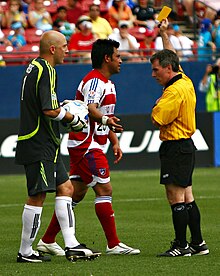Yellow card


With the yellow card (also yellow card ) in some sports (e.g. soccer , handball , volleyball ) the referee will issue a warning due to violations of the rules of the game or unsportsmanlike behavior. In the case of gross violations, however, there is no warning, but a direct dismissal with the red card .
General
In the event of rule violations in football that do not justify a red card but would have to be punished with the yellow card for the second time, a yellow-red card is issued.
After a yellow (or red or yellow-red) card, the game may only be continued when the referee has released it with a whistle. If the ball is played too early, this will also result in a yellow card if the rules are interpreted precisely.
Multiple yellow cards received in different matches in a competition may result in a yellow card suspension .
In colloquial language, the phrase “show someone the yellow card” stands for a mostly informal warning.
In handball, the yellow card only means a warning. A two-minute penalty is imposed in place of the second yellow card. There the referee can only give three yellow cards per team. Thereafter, only time penalties would be possible for such offenses .
In many sports, a yellow card means not only a warning but also a time penalty for the player concerned. In hockey it can be anywhere from two to 15 minutes. In rugby union and rugby league , a player must leave the pitch for ten minutes (he must go to Sin Bin) when shown a yellow card. In volleyball, a yellow card means a warning to the team in question; if its members continue to act improperly, it threatens a red card (point and loss of information), but otherwise has no consequences.
history
At the soccer world championship in 1966 there were turbulent scenes on the field during the game Argentina against England , which were due, among other things, to the fact that an Argentinian player did not understand or wanted to understand the expulsion verbally pronounced by the German referee Rudolf Kreitlein and still almost did remained on the pitch for nine minutes. In the tumult that followed, they even failed to notice warnings against English players. The audience did not notice either. Similar scenes occurred in the game between Chile and Italy at the 1962 World Cup, known as the Battle of Santiago. In this game, which is considered to be one of the most brutal in World Cup history, several players were sent off and some players physically attacked others and hurt them. Players pretended not to understand the referee's signals.
To avoid such misunderstandings, by English referee Ken Aston , who led the game Chile-Italy and during the 1966 FIFA World Cup was referee supervisor before, analogous to the internationally known traffic light installations (traffic lights) Yellow and red cards to use. This idea came to him while driving a car. He had to stop in front of several traffic lights that changed from “yellow” to “red”. This scheme was used for the first time at the 1970 World Cup and quickly caught on. Kurt Tschenscher led the opening game of the 1970 World Cup in Mexico and was the first referee to ever receive a yellow card.
Since 1991 there has also been the yellow-red card in football , which indicates a dismissal that would not have been issued without a prior warning and thus visibly differentiates the measure from a “straight red” card. It is also referred to as a “traffic light card”, revisiting the idea of Ken Aston, and is also considered a dismissal, but in contrast to the red card drawn without prior warning, it generally only results in a ban for the immediately following game in the same competition. The sanctions that a yellow-red card entails are regulated differently in the lower divisions (regional leagues to regional leagues) depending on the regional association in Germany.
The coloring of the two cards is also traced back to the requirements of the television broadcasts. Since at that time many televisions only displayed black and white images, cards with clear contrast had to be selected.
Time penalty
The yellow card is not a warning in every sport. In hockey , rugby and canoe polo , the yellow card is used to indicate a time penalty. In field hockey the player has to leave the field for 5 to 15 minutes, in indoor hockey 2 to 10 minutes. In rugby, after receiving the yellow card, the player has to go to the penalty box for 10 minutes (also known as "sin bin"). In canoe polo, the player concerned must leave the field for 2 minutes. In all three sports, the punished team has to get along with one less player during the time penalty.
